|
|
Adjusting the Mounting Station's Film Suspension Height |
|
|
|
Adjusting the Mounting Station's Film Suspension Height |
|
The optimum film suspension height for your particular scanner unit may actually vary from the standard 1.0, 2.5, 3.0 or 3.5 mm suspension heights provided by the OEM Epson holders. The mounting station for the Epson V Series has a starting base film suspension height right at 1.5 mm. Mounting stations for all other Epson scanners have a base film suspension height right at 1 mm.
Adjusting the Set Screws
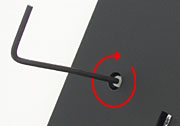 |
A small L-shaped hex key has
been included to turn/adjust the holder's set screws. Insert the hex key
gently into the socket as shown.
BEFORE YOU START TO TURN THE
KEY, MAKE SURE IT IS FULLY INSERTED INTO THE SOCKET.
Failure to do this could mean the key will
not engage and thus not fully turn the screw. This would cause
that adjuster to become out of sync with the others. If this
happens, you will need to start again at the zero position (see below). |
The Zero Position
You must begin your testing session with all of the set screws set to the "zero position" which means the bottom of the set screw is flush with the bottom surface of the holder. This can be accomplished via the following steps:
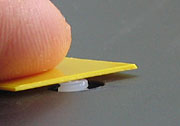 |
Turn the set screw so that it protrudes out slightly from the underside of the film holder. Place an object that is known to be flat against the top of the screw (the included square piece of colored shim stock is used in this example). |
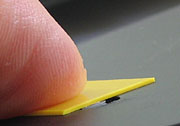 |
Maintain moderate pressure on the shim piece. Slowly reverse the set screw to the point the shim piece just comes into flat contact with the bottom of the holder. Do not turn any farther. If in doubt, repeat the procedure. Please note how the flat shim square only HALF covers the set screw so that you are able to better see/judge when the two come into contact. |
The Contact Surface of the Set Screws
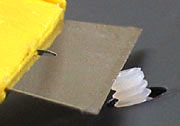 |
Since the set screws are molded nylon, the bottom surface of the set screw (the part of the set screw that actually touches the scanner's glass) can have some imperfections on it. If you prefer a flatter surface, you can easily trim the nylon with a sharp razor blade. |
Determining an Adjustment Increment
The bent "L" end of the hex key will serve as your adjustment indicator. If possible, always insert the key so that it points to the 12 o'clock position for the starting point before you begin adjusting. This will make it easier to estimate increments such as quarter and half turns. If you cannot insert the hex key at the 12 o'clock position (due to the previous adjustment you made for the zero position), insert the hex key as close as possible to the 12 o'clock position and then make a pencil mark to denote that offset point. This pencil mark will then be used as the starting point reference mark.
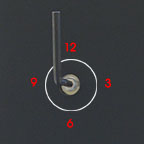 |
The following table shows
the linear relationship between key turns and height adjustment:
1/4 turn (e.g. from 12 to 3) = .2 mm |
If it took a number of individual increment adjustments to achieve your new optimal height, it is possible any incremental turning errors from each of the individual turns add up to an amount where there is a noticeable variation between individual set screw heights. Once you have determined your initial new optimum height, it can be a good idea to reposition the set screws to their zero point and adjust them back to the new height as a single adjustment (e.g., make an adjustment to +1.2 mm in one adjustment of 1.5 full turns vs. 6 individual quarter-turn adjustments).
The goal is to extend each of the holder's set screws an equal amount from the bottom surface of the holder in order to evenly raise the holder/film suspension height to match the optimum position for your particular scanner.
Methodology
To determine the optimum suspension height for your particular scanner, you will need to test by making multiple test scans using the same piece of film. This piece of film must be left in the same position within the mounting station for each of your test scans. Be very careful handling the mounting station between each test scan.
Different methods can be used for testing. If you have never experimented with shimming your Epson holder, the slower methodical approach may be the best. Utilize a fairly fine/small adjustment increment such as .2 mm (1/4 turn) from the beginning. Start with a zero height adjustment "base" scan and then create a series of scans where each subsequent scan adds .2 mm in height. You must adjust each one of the set screws AND adjust them by the same amount (e.g. 1/4 turn to raise the holder by .2 mm) in order to raise the holder evenly. Compare each new scan against the previous one. As long as each subsequent scan appears better than the previous one, continue to raise the mounting station by another increment and make another scan. Depending on the size of the adjustment increment used, it may take multiple adjustments before you actually notice an appreciable difference. Once the newest scan appears to be less sharp than the previous scan, the mounting station is past the optimal height. Reconfirm which previous scan was the sharpest and revert back to that height setting.
If you have previously done shimming tests and already know your particular scanner requires a significant amount of height adjustment, you may want to start out utilizing a relatively "coarse" adjustment increment such as .4 mm or .6 mm to quickly determine the general range for the optimum focus height. Once you have determined the general range, make additional test scans using a more "fine" adjustment increment such as .2 mm. Scan at both a +.2 mm and - .2 mm adjustment to determine whether you need to progress in a plus or minus direction. This approach can save you time if your particular scanner's optimum height is quite a bit more than the standard height.
Periodic Adjustment
It will be a good idea to periodically retest for your scanner's optimum film suspension height. If internal changes within the scanner occur over time, or if a set screw's position gets altered, it will mean an adjustment is necessary.
Correctly Placing the Mounting Station's Frame on the Scanner
The black frame component of the mounting station is usually kept on the scanner's glass bed. The glass plate is removed and then the film is mounted to the glass plate on a workspace away from the scanner. This design means there is less of a chance of damaging your scanner with excess or spilled fluid.
|
|
The mounting station's frame should be placed on the scanner's glass so both the top and right edges of the frame are in contact with the top and right edges of the scanner's glass bed. It is a good habit to make it part of your workflow to re-check the position of the mounting station frame each time you insert the glass down into the frame. (During long scanning sessions when scanning many pieces of film, some people like to temporarily tape the frame in position on the scanner so it canít be accidentally moved.) |
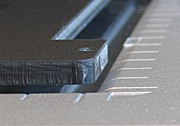 |
The inside edges around an Epson scanner's glass bed are not straight up and down. Instead, they are partially beveled/angled. With certain scanners, it may be necessary to raise the mounting frame a significant amount. When the adjustment amount exceeds 1.5 mm, the bottom edge of the frame will rise enough to be able to encroach into this beveled area. |
|
|
When this occurs, insert the four edge screws in the positions noted by the arrow heads in the image at the left. There are two along the top (one in each "ear" of the holder) and two along the right side. (The extra four edge screws can be found in the same bag containing the hex key and colored plastic shim square.) |
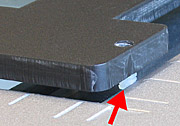 |
Insert the edge screws far enough so they almost touch the glass. (Do not insert them far enough to touch the glass since that might alter the calibrated height of the film holder.) The lowered edge screws will prevent the mounting station's frame from "riding up" over the edge surrounding the scanner's glass. |
 |
The frame is designed so the weight of the scanner's lid when closed ensures the frame is always pressed flat against the scanner's glass. Depending on your scanner model, your mounting station's frame may have bumpers attached to the top side. The surface on top of the rubber bumpers can have a great deal of grip/stick. If they begin to stick to the scannerís transparency adapter when you open the lid, put an extremely fine coat of baby/talcum powder on the top surface. Gently wipe off any excess powder. This will eliminate the sticking. |
Back to the Page You Were Previously
Viewing
E-mail Contact: scanning@betterscanning.com
All information contained in this website ©2024 by DSF OmniCorp, LLC and Doug Fisher. This information may not be reproduced in whole, part or spirit without written permission.
MF Film Holderš
Patent Pending